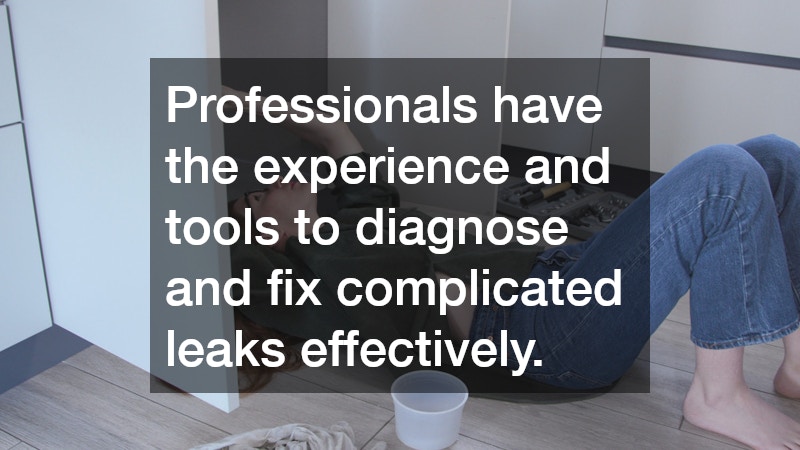What to Try Before Hiring a Local Leak Detection Service
Understanding and managing potential leaks in your home is crucial to avoiding costly repairs and water damage. Before enlisting professional help, there are several steps you can take to identify and address leaks on your own. This article will explore approaches and techniques you should consider before hiring a local leak detection service.
How Can I Identify a Leak on My Own?
Visual Inspection Techniques
Start by conducting a thorough visual inspection of all visible plumbing connections, appliances, and water fixtures. Look for signs of water damage, mold, or discoloration on floors and walls.
Identifying areas that regularly retain moisture can help pinpoint sources of leaks.
Examine under-sink areas, around bathtubs, and near toilets where leaks are common. Also, check exterior home areas for signs of leaking, including water pooling or soggy patches. Regular inspections can help catch leaks before they escalate into major problems.
Please pay attention to any unexplained water stains on ceilings or walls, as they might indicate hidden leaks from upper floors. Wooden floors that appear warped or have a musty smell are also indicators. Detecting changes in these areas early can significantly reduce repair costs.
Monitor Your Water Meter
One effective method involves observing your water meter. Ensure all water outlets are off and note the initial meter reading.
Wait an hour or two without using water, then check if the meter has changed. If the meter reading increases, it indicates a possible leak somewhere in your system.
This method helps you identify leaks that might not be immediately visible. Performing this test regularly can reveal hidden leaks early, allowing for prompt action before water consumption spikes unexpectedly.
What Are Some Quick Fixes I Can Try?
Applying Temporary Patch Solutions
If you discover a small leak, applying plumber’s tape or sealant can temporarily hold the leak at bay. These materials are cost-effective solutions that provide immediate relief.
For the best results, ensure surfaces are dry before application. This prevents patch adhesive failures and ensures maximum efficiency.
While these solutions are not permanent, they prevent excessive water loss and give you time to plan for more substantial repairs. Quick patches are essential for preventing further damage while awaiting professional help.
Tightening Connections
Loose fittings and joints often cause leaks. Carefully tighten any loose connections using a wrench, especially at washers, valves, and faucets.
Be cautious not to overtighten, as this can cause further damage. Properly tightened connections significantly reduce the potential for leaks.
This simple maintenance can save you the trouble of larger repairs later on. Regularly tightening connections helps maintain the integrity of your plumbing system. It’s a preventive measure that can dramatically extend the lifespan of fixtures.
Are There DIY Tools I Can Use?
Leak Detection Gadgets
Investing in affordable local leak detection service gadgets can help pinpoint leaks. Electronic leak detectors can monitor moisture levels and alert users to trouble spots.
These tools are easy to use and highlight unseen leaks behind walls or under floors. They provide a technological edge in detecting early stages of leak development.
For small investments, these gadgets offer substantial peace of mind. They’re handy in continuously monitoring potential problem areas. By utilizing these tools, you can proactively manage your home’s plumbing health.
Utilizing Household Items
Common household items, like food coloring and dish soap, can help detect leaks. For example, place a few drops of food coloring in your toilet tank; if the color seeps into the bowl without flushing, you likely have a leak.
This simple test helps determine if you need to replace your toilet flapper. Another method involves using dish soap at pipe joints to spot bubbling caused by escaping water or air.
Employing these methods isn’t only cost-effective but also requires little technical know-how. They serve as preliminary checks before resorting to more complicated solutions. Quick at-home testing can help you gather information before calling in experts.
When Should I Call a Professional?
Signs of Severe Water Damage
If your inspections reveal significant water damage, such as large patches of mold or structural damage, it’s crucial to call a professional immediately. Persistent water damage can lead to serious health risks and expensive repair needs.
Professionals have the experience to assess and remediate water damage thoroughly. They can assure that all damaged areas are adequately treated to prevent recurrence.
Acting swiftly in these scenarios prevents the exacerbation of existing damage. Professional intervention at this stage is critical to safeguarding your property. Ignoring severe signs can lead to unwanted complications and expenses.
Persistent or Hard-to-Find Leaks
Leaks that persist despite DIY efforts should be assessed by a professional. Likewise, those difficult to locate require specialized tools and skills.
Professionals have the experience and tools to diagnose and fix complicated leaks effectively. Their advanced methods surpass basic household detection techniques.
A professional’s thorough evaluation ensures a comprehensive solution to the problem. Addressing persistent leaks holistically prevents future incidents. Sometimes, professional insight is necessary for peace of mind and efficiency.
Taking proactive steps to identify and manage local leak detection services can save you time and money. By using the outlined methods and understanding when to seek professional assistance, you can assure your home remains leak-free and avoid potential water-related disasters.

